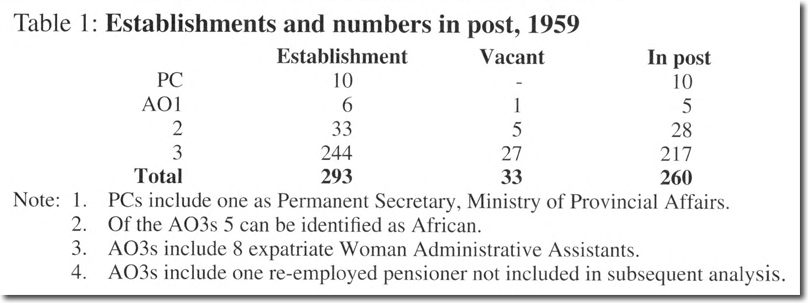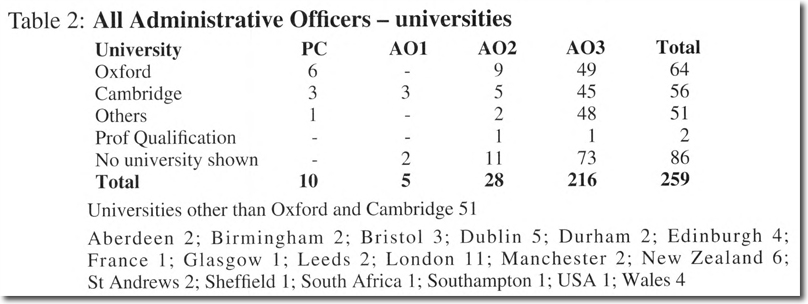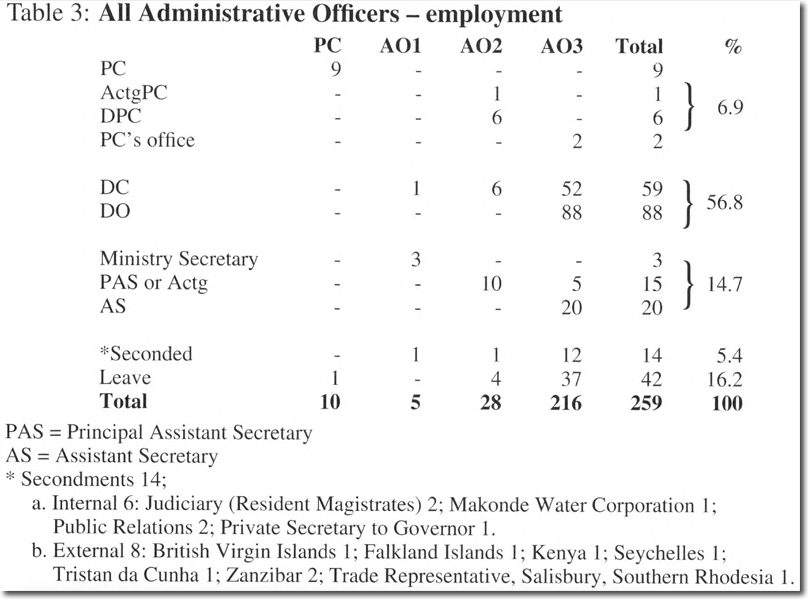|
This article draws from the Tanganyika Government Staff List of September 1959
("the list") to offer some information about administrative officers of Class III and above -
Class III was the basic grade. Those considered are officers under the "Administration"
heading in the list, including those in ministries and central departments or on secondment
within or outside the territory. Significant biographical information in the list is the date of
birth of male officers, the date of first appointment and the officer's university degree, if any.
Tanganyika Territory, the former German East Africa, now with Zanzibar part of the
Republic of Tanzania, was from 1922 administered under a League of Nations mandate
and then as a United Nations trust territory. Its government was conducted on the same
lines as those of other British colonial territories. The Governor was responsible to the
Secretary of State for the Colonies and the Colonial Office, and its public services were
staffed by locally appointed officers and by expatriate members of the Colonial Service,
later HM Overseas Civil Service. Tanganyika became independent in December 1961.
The land area of Tanganyika is 340,000 square miles (880,600 sq km). In 1959 the
total population was about 9,000,000, of which about 120,000 were of non-African
origin. The greater part of the non-African population lived in the capital, Dar es Salaam,
and the other main towns.
In preparation for internal self government and eventual independence the former
government secretariat and the headquarters of the technical departments had by
September 1959 been reorganised into 12 ministries, each headed by a minister and a
permanent secretary on the Whitehall model. For administrative purposes the territory
was divided into 9 provinces, and a further into 59 districts, including the Dar es Salaam
extra-provincial district. Each province had as its head a Provincial Commissioner (PC),
this being a rank within the service as well as an appointment; each PC usually had as
his deputy (DPC) an Administrative Officer Class II (A02), and sometimes an
Administrative Officer Class III (A03) as a staff officer. Each district was under a
District Commissioner (DC), this being an appointment and not a rank. Some large
districts were headed by A02s, but most by A03s. DCs were supported by one or more
A03s, usually referred to as district officers (DOs). A substantial number of AOs of all
grades was employed in the central ministries and departments.
 |
Expatriate officers were entitled to 2 months leave in a temperate climate for each
year of service in the territory; this meant that with an establishment of about 290
officers about 48 or 16.5% could be expected to be on leave at any one time. In 1959 42
(16.2%) of the 259 available officers were on leave and 217 in the territory.
Tables with annual appointment figures and detailed information for each of the 4
grades are in the original paper, but are not included in this article. The author's
comments are based on those tables. Tables 2 and 3 below are summaries of this
information excluding that relating to age on appointment.
The annual figures for first appointments show the expected very low numbers in the
years 1940-45 and high numbers in the immediate post-war years, with a peak of 33 in
1950. Most surprising is the high level of recruitment in 1956-59, with 63, 29% of all
A03s, joining in those 4 years. The 19 in 1958 is the third highest figure for a single
year. This high level in the pre-independence years is contrary to what Kirk-Greene has
found for the service as a whole (On Crown Service, IB Tauris, London 1999). The only
possible explanation seems to be optimism amongst those responsible for recruitment
about the future for administrative officers in an independent Tanganyika.
 |
The administrative service recruitment ideal, or norm, of the 1930s is made clear by
Sir Ralph Furse's book Aucuparius: Recollections of a Recruiting Officer (Oxford U P,
London 1962). Furse had worked in the Colonial Office on colonial service recruitment
from 1910 and had been Director of Recruitment 1931-48. The norm was a man who had
left school at about age 18, had graduated after 3 or 4 years at the university, preferably
with a respectable 2nd class or better, though a 3rd class was acceptable. The recruit had
then spent a further academic year on the administrative service training course at
Oxford or Cambridge, almost all recruits in the 1930s being from these 2 universities.
The new entrant was thus about 22 or 23 years old when he started work.
Prom 1929 to the early war years the Tanganyika administration conformed to the
norm. The 1939-45 war left the service seriously under strength, and recruitment was
stepped up. In the period 1945-50 the average age of first appointment was in the late
20s, the highest recorded age being 43. From 1951 onwards the average began to fall, to
25 in 1951-53 and then to about 24. The 2 year difference between the pre- and post-war
averages was caused by the requirement up to 1960 for all UK resident British males to
do military service for 18 months or 2 years.
The educational background of the administrative service was also changed by the
war. Many men went straight from school into the armed services, others after a year or so at the university. Of these some returned to finish their degrees, others wanted to start
a new career with a minimum of further time or training. To meet the need to build up
the service quickly a university degree was waived as an entry requirement. Although
the first non-university entrant is recorded in the list in 1940, the great influx came in the
immediate post-war years. From 1945 to 1950 there were marginally more non-graduates
than graduates, and though graduates predominated from 1951 onwards there
was always, in contrast to the 1930s, a significant number of non-graduates, with as
many as 12 out of 51 in 1957-59.
As well as a change in the average of new entrants the post war years produced a
change amongst the graduate entrants. With 2 exceptions the pre-war appointees still
serving in 1959 were all from Oxford and Cambridge. After 1945 other universities are
strongly represented. The 51 "other" graduates include 6 from New Zealand (none from
Australia) and only one from South Africa; only London with 11 is in double figures.
Oxford provided the largest number of graduates, but the largest single category is the
non-graduates, with 86 (33.2%) out of 259.
 |
Table 3 shows how thinly the service was spread. In the most important category, the
districts, there were 147 officers or 56.8% of the total of all grades, which was one
officer for every 61,000 inhabitants. As there were by 1959 no one-man districts, and
118 officers were required as a minimum to staff the 59 districts, there were thus only 29
districts where there could be more than one DO in addition to the DC. More significant
is the reliance on officers still in their first tour of duty. Of the 147, 48 or 32.7% had
entered the service in the years 1957-59, and the 35 entrants in 1958 and 1959 had not
yet been confirmed in their appointments - confirmation was after 2 years of satisfactory
service and the passing of law and language examinations. The 38 (147%) officers in the ministries represented a substantial obligation, though it was not a new one, but it was a
call on more experienced officers, as it was not usual to post to the ministries and the
former secretariat officers with less than 3 years' service, more usually 6 years. Perhaps
more surprising is the 14 (5.4%) officers seconded to other duties (6) and territories (8).
This study has served to give detailed information about what was previously
superficial or anecdotal - the post-war expansion of recruitment, accompanied by a
substantial entry of non-graduates, and the distribution of A02s and A03s between
different tasks and duties. Most striking is the fact that expatriate AO recruitment was so
buoyant up to 1959 (only 2 years before independence) and that as much as a third of
officers in the districts had 2 years service or less. The transfer of power in 1961 to
African majority rule was amicable and peaceful - it must be doubtful whether such a
thinly spread and inexperienced district administration could have coped otherwise.
|
